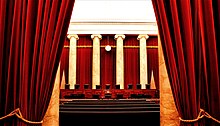
Back قانون الولايات المتحدة Arabic بیرلشمیش ایالتلرین حوقوقی سیستمی AZB Dret dels Estats Units Catalan یاسای ویلایەتە یەکگرتووەکانی ئەمریکا CKB Recht der Vereinigten Staaten German Derecho de los Estados Unidos Spanish حقوق ایالات متحده آمریکا Persian Yhdysvaltain laki Finnish Droit aux États-Unis French Mî-koet Fap-li̍t HAK



The law of the United States comprises many levels of codified and uncodified forms of law,[1] of which the supreme law is the nation's Constitution, which prescribes the foundation of the federal government of the United States, as well as various civil liberties. The Constitution sets out the boundaries of federal law, which consists of Acts of Congress,[2] treaties ratified by the Senate,[3] regulations promulgated by the executive branch,[4] and case law originating from the federal judiciary.[5] The United States Code is the official compilation and codification of general and permanent federal statutory law.
The Constitution provides that it, as well as federal laws and treaties that are made pursuant to it, preempt conflicting state and territorial laws in the 50 U.S. states and in the territories.[6] However, the scope of federal preemption is limited because the scope of federal power is not universal. In the dual sovereign[7] system of American federalism (actually tripartite[8] because of the presence of Indian reservations), states are the plenary sovereigns, each with their own constitution, while the federal sovereign possesses only the limited supreme authority enumerated in the Constitution.[9] Indeed, states may grant their citizens broader rights than the federal Constitution as long as they do not infringe on any federal constitutional rights.[10][11] Thus U.S. law (especially the actual "living law" of contract, tort, property, probate, criminal and family law, experienced by citizens on a day-to-day basis) consists primarily of state law, which, while sometimes harmonized, can and does vary greatly from one state to the next.[12][13] Even in areas governed by federal law, state law is often supplemented, rather than preempted.[citation needed]
At both the federal and state levels, with the exception of the legal system of Louisiana, the law of the United States is largely derived from the common law system of English law, which was in force in British America at the time of the American Revolutionary War.[14][15] However, American law has diverged greatly from its English ancestor both in terms of substance and procedure[16] and has incorporated a number of civil law innovations.
- ^ O'Neill, Cara, ed. (2021). Legal Research: How to Find & Understand the Law (19th ed.). Pleasanton: Nolo. pp. 5–6. ISBN 9781413328882.
- ^ Ex parte Virginia, 100 U.S. 339 (1880).
- ^ Head Money Cases, 112 U.S. 580 (1884).
- ^ Skidmore v. Swift & Co., 323 U.S. 134 (1944).
- ^ Cooper v. Aaron, 358 U.S. 1 (1958).
- ^ William Burnham, Introduction to the Law and Legal System of the United States, 4th ed. (St. Paul, MN: Thomson West, 2006), 41.
- ^ Gregory v. Ashcroft, 501 U.S. 452 (1991).
- ^ Kowalski, Tonya (2009). "The Forgotten Sovereigns". Fla. St. U. L. Rev. 36 (4): 765–826.
- ^ United States v. Lopez, 514 U.S. 549 (1995).
- ^ Pruneyard Shopping Center v. Robins, 447 U.S. 74 (1980).
- ^ California v. Ramos, 463 U.S. 992 (1983).
- ^ Hughes, Graham (1996). "Common Law Systems". In Morrison, Alan B. (ed.). Fundamentals of American Law. Oxford: Oxford University Press. pp. 9–26. ISBN 9780198764052. Retrieved August 11, 2020.
- ^ Friedman, Lawrence M. (2019). A History of American Law (4th ed.). Oxford: Oxford University Press. p. 646. ISBN 9780190070915. Retrieved August 11, 2020.
- ^ Hughes, Graham (1996). "Common Law Systems". In Morrison, Alan B. (ed.). Fundamentals of American Law. Oxford: Oxford University Press. pp. 9–26. ISBN 9780198764052. Retrieved August 11, 2020.
- ^ Friedman, Lawrence M. (2019). A History of American Law (4th ed.). Oxford: Oxford University Press. p. 3. ISBN 9780190070915. Retrieved August 11, 2020. Professor Friedman points out that English law itself was never completely uniform across England prior to the 20th century. The result was that the colonists recreated the legal diversity of English law in the American colonies.
- ^ White, G. Edward (2012). Law in American History, Volume 1: From the Colonial Years Through the Civil War. Oxford: Oxford University Press. pp. 49–50. ISBN 9780195102475. Retrieved August 11, 2020.